It will cost you a fortune, but it is not just a sensual gastronomic indulgence: it is an immersion in the most spiritual view Paris has to offer, and a step back in time to the Belle Epoque so convincing that you may think you’ve stepped through a time warp into a Midnight in Paris encounter with the past.”
Three springs ago, I did something outrageous, even reckless, on the food and finances front: I secretly made a dinner reservation at Tour D’Argent to celebrate a special anniversary, and presented my husband with the fait accompli as we sped on the EuroStar through the Channel Tunnel to the City of Lights. He gulped, and I feared the plan would be quashed, but the celebratory anticipation of our trip, my pleading expression, and his desire to experience a place he first heard of with longing when he was 22, won him over.
This icon of French gastronomy holds one Michelin star today, and its pressed duck has been legendary since it was invented in 1890 by the once-head-waiter-then-owner Frédéric Delair. So while the menu included fish, beef and lamb, there was never any doubt it would have to be the bird. Each duck, of the ancient Challandais breed domesticated from the wild duck of the marshlands of the Vendée region, is raised by the same family in Challan that has been supplying Tour D’Argent for sixty years. In a formality decreed by Delair, each duck is individually numbered, its credentials presented to the diner on a card bearing Delair’s portrait. The millionth duck was served in 2013.
The pressing is achieved by an ornate instrument of polished silver that looks like an elegant instrument of torture or a very classy apple press. It has for generations crushed the carcass of each bird after its breasts and legs are removed, to extract the juices and flavour of the bones in all their (literal) gutsiness, to be strained and reduced into a rich, dark, blood sauce. The station in the centre of the restaurant where a ‘canardier’ in a tuxedo carves, then crushes, then whisks juices on a silver platter over a silver cauldron, flames them with cognac, adds champagne and stirs and strains some more lifting his silver ladle high, is a mesmerising performance that, on the night we were there, was illuminated by a spectacular sunset over Notre Dame Cathedral.
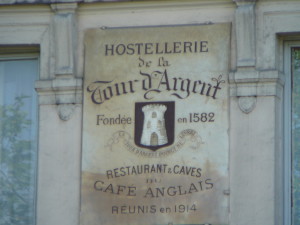 Tour D’Argent is on the corner of a busy city junction, and you must ascend in a lift that looks a little shabby if you compare it, say, with Fortnum’s or Liberty’s, to reach the dining room on the 6th floor, situated for its view over the Seine and the cathedral’s flying buttresses. We were greeted by a young doorman to whom we felt it necessary to explain that we had finally managed to make it there after dreaming of it for 30 years. He seemed to have heard that story before. All youthfulness gave way once the lift doors opened, to a sense of age, of 17th century splendour, as though we were about to dine in one of Louis Quatorze’s private rooms. And the view dominated, with vast windows all around the dining room, making it feel larger than it is. The tables were perfectly spaced and it seemed that all would have a share of the view. Red velvets, gold, white linens, silver and glass — everything sparkled — and the carpet was so soft it was almost difficult to walk on. I felt hushed by splendour, delighted by our table, delighted by my companion’s delight. The spell was cast. Our hunger began to rise.
Tour D’Argent is on the corner of a busy city junction, and you must ascend in a lift that looks a little shabby if you compare it, say, with Fortnum’s or Liberty’s, to reach the dining room on the 6th floor, situated for its view over the Seine and the cathedral’s flying buttresses. We were greeted by a young doorman to whom we felt it necessary to explain that we had finally managed to make it there after dreaming of it for 30 years. He seemed to have heard that story before. All youthfulness gave way once the lift doors opened, to a sense of age, of 17th century splendour, as though we were about to dine in one of Louis Quatorze’s private rooms. And the view dominated, with vast windows all around the dining room, making it feel larger than it is. The tables were perfectly spaced and it seemed that all would have a share of the view. Red velvets, gold, white linens, silver and glass — everything sparkled — and the carpet was so soft it was almost difficult to walk on. I felt hushed by splendour, delighted by our table, delighted by my companion’s delight. The spell was cast. Our hunger began to rise.
To start, my other half had the pate de foie gras trois Empereurs, served with a sauterne and a port jelly, and brioche. He still raves about the whole truffle that the waiter scooped from the silver urn onto his plate with the curls of foie gras. I had the earthier pike quenelles, which I had always wanted to taste since reading about this classic dish 30 years ago in Escoffier’s cookbooks. This was the place, I knew, to experience them at last. They were less fishy than I expected, and not as ethereal, but they were delicious with a rich sauce of duxelle and mornay sauce browned under the grill. A diner at a nearby table had a spectacular asparagus starter arranged like a castle of spears with lobster mousse filling, which I would certainly order if I went again in the season.
The duck made its appearance with understated ceremony. The breasts were presented first, medium rare without their skin (a surprise for me), on a plate generously surrounded by the sauce we had watched the canardier make, garnished simply with four souffled potatoes so thin they hardly constituted a carbohydrate. I have never been served such puffs of potato air before, and wonder how many the chef had to cook to get four per plate to come out as such perfect little pillows. The sauce was gamey and strong; we could taste what was pressed out of the bird, a feral note of heart and liver. The fruitier sauces that were also on offer may be more to modern tastes, but I wanted to experience the original. It was indeed memorable, and in contrast to the surroundings, was a little “of the barnyard” in the way of an esteemed old burgundy. Then the leg arrived, and this is when my taste buds started to celebrate rather than revere. It was crisp and delicious (with no sauce — a contrast of textures and tastes from the magrets) and the acidic dressing of a bitter salad was refreshing after the first meaty serving of duck.
My companion was struck dumb by the solemnity of the wine list, and reported that being presented with the 400-page tome was one of the highpoints of his life. There was one moment when I nearly fainted, thinking he was about to order a 300 € glass of sherry, but he settled on the 180 € bottle of 1999 Morey Saint Denis (Dujac) Burgundy and a 19 € aperitif, a turbid, chocolate-coloured Amontillado Early Landed.
The finale was also, for me, a fulfilment of a lifetime’s imaginings: flaming Crêpes Belle Époque, set alight in an long-handled copper pan at our table by another white-hatted artist with the gravitas of a priest offering communion. I have made crepes almost as delicious at home, but never, it goes without saying, could I recreate that atmosphere of candlelight and flaming Grand Marnier dancing against silver and sunset. David, to finish, had what may have been the most charming taste of the evening: the best mint sorbet we have ever tasted, even perhaps the best sorbet. I have tried twice to recreate it at home, and it still eludes me completely. The balance and texture were superb. I have been obsessed with that mint sorbet ever since, and will not die content if I can’t figure out how it was made. It seems sacreligious to have liked the simple sorbet better than the breast of the duck that made the restaurant’s reputation, but it was truly a work of the glacier’s art, and celebrated the herb as beautifully in its way as the press celebrated duck number 1,109,864.
The service was 100% masculine and invariably 7-foot tall counting hats, authoritative but not authoritarian, formally genteel, but never condescending. It was perfectly paced, and I felt as comfortable there as a person could, knowing they are eating and drinking beyond their means. We were in the hands of masters who knew how to make us feel at the centre of the experience.
The cost of our one dinner, at 586 € for three courses plus aperitif, wine and water, coffee and petits fours, and an after-dinner Armagnac, could have bought our groceries for some weeks. But we can’t think of it like that. It was in itself a holiday, a trip to another world and another time, the value of which cannot be measured by the four hours we were actually there. It was like stepping into the pages of Escoffier: seeing come to life an entire world we knew only from imagination. Its Empire old-fashionedness was what made it, not really the food in itself, which was wondrous, but so are other Michelin-starred restaurants. We loved it because it was the antithesis of innovation and reinvention. It was feeling not just young again, but young again in an earlier generation. It was like eating history, embodying it, literally. We loved it because it reflects a disappeared world.
The cost of our dinner meant we stayed in Paris for three nights rather than five, but that is our kind of logic. We run an ancient banger, bought for £350 four winters ago, so we can occasionally do such things. Food is near the top of our priorities. Cars near the bottom. It’s a good enough business plan in our house. In all honesty, though, I am not sure I could recommend Tour D’Argent with a clear conscience to someone of our means who was not an afficionado of culinary history, or in other ways obsessed with the romance of food and the French gastronomic tradition. I think of my parents, who also love food and its stories, but would be uncomfortable with the price tag, and I confess I haven’t told them of this extravagance. But how I would love them to experience this.
Alas, the MOT on the old banger is coming up in a few weeks and I fear we won’t be returning to La Tour D’Argent anytime soon. I’m not sure we’d want to anyway. Perhaps it truly was a once in a lifetime experience we should treasure in memory rather than trying to recreate. Would the magic that transported us back two centuries work a second time? Or will my beloved, some decade or so hence, surprise me in turn with an invitation to chance our luck and play with time once more?
La Tour d’Argent
www.tourdargent.com
+33 (0) 1 43 54 23 31
15-17 Quai de Tournelle
75005 Paris
*Reservations essential*
Prices
The three course pris fixe lunch menu, without wine, water, coffee or other drink, is a bargain at 75 € per person. You get the same silver service and a daytime view of Notre Dame, and three or four choices for each course, including duck fillet.
Our selection from the a la carte menu cost:
- Pike quenelles André Terrail, 52 €
- Goose Foie Gras des Trois Empereurs, 86 €
- Tour d’Argent duckling, shared between two, 140 €
- Crêpes Belle Époque, 35 €
- Selection of sorbets, 19 €
- Two coffees, served with petits fours, 20 €
- 2 large bottles of Perrier, 26 €
- 1 bottle Morey Saint Denis (Dujac) Burgundy 1999, 180 €
- 1 glass Amontillado Early Landed, 19 €
- Bas Armagnac Tour D’Argent, 27 €
- 15% service compris 61 €
Total: 586 €
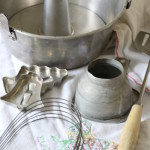

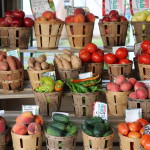
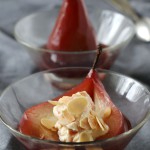
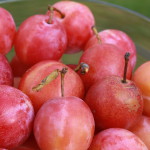
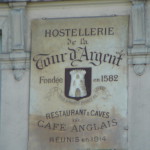 Tour D’Argent: a remembrance of things past at today’s prices
Tour D’Argent: a remembrance of things past at today’s prices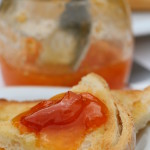 Apricots, les abricots
Apricots, les abricots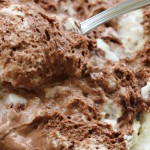 I used to cook in a piggery
I used to cook in a piggery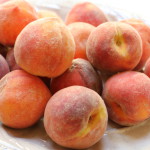
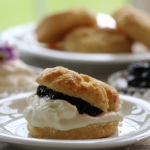
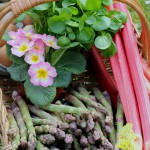
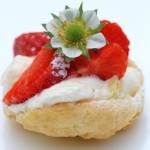
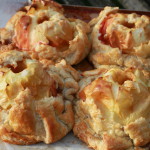
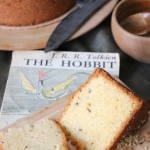 Seed cake and story
Seed cake and story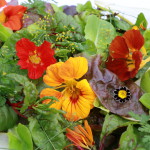
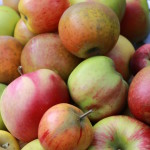

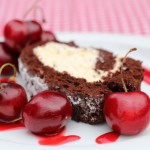
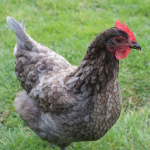
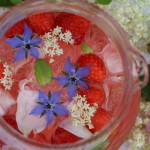
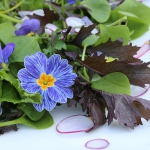

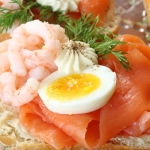
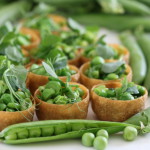
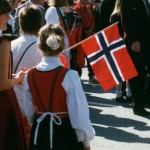
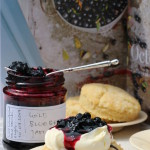
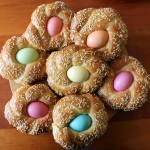 Easter is late this year
Easter is late this year
Leave a Reply